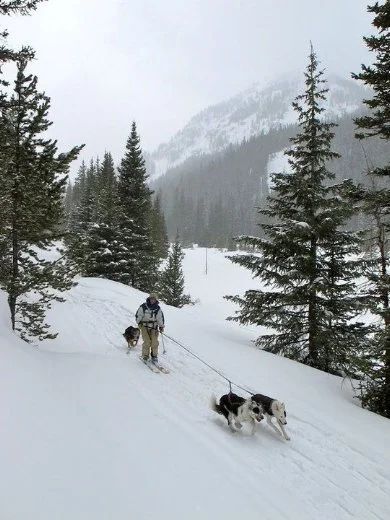Skijoring is a Norwegian word that means "skidriving." A team of one or more dogs pulls an xc skier and the skier "drives" or directs the team as he or she skis behind. In Scandinavia, skijoring has been done for centuries and it is gaining popularity in the US. It's easy to learn and can lead to magical winter days for you and your canine friend. Skijoring will help keep your dog fit and healthy and it can deepen and enhance the relationship that you have with your dog. Learning to work with your dog and become a team is a great reward that skijoring has to offer.
The Skier
The human aspect of skijoring requires skiing ability, dog training, and handling skills. Any XC ski gear can be used for skijoring and classic or skating ski techniques can be used. The type of ski selected depends on the experience that your desire such as how fast you want to ski and how far you want to go. Expect that a fast running dog on a groomed ski trail will be very quick and skating might be the best choice.
If you are new to XC skiing, it is recommended that you take ski lessons and practice prior to trying skijoring with your dog. Ski ability requires that you are able to control your speed, stop, and keep balance. But as previously mentioned, skijoring is a team activity and you should expect to work as hard as your dog. It is not a FREE RIDE!
Dog training and handling skills are equally important so it is useful if you and your dog have participated in an obedience class together. Key elements include being positive, patient, and consistent. Positive reinforcement is important with any animal training and short easy sessions will yield great results. You want to feel successful and gain confidence together.
The Dog
No matter the breed (above 30 pounds), dogs have a strong instinct to chase, run on a trail, or hunt as a pack. While sometimes this instinct can result in unwanted behavior, when carefully shaped and trained, it also enables your dog to pull. One of the easiest ways to teach your dog skijoring is hooking him/her up with an experienced skijoring or sled dog team. Another method that works is to have someone ski slightly in front of your dog and call it, while you let it pull you.
Some dogs may learn immediately and others may take a little more work and encouragement, but keep things in perspective.
Dogs need adequate water and it is recommended not to run them on a full stomach. They can overheat in warmer temperatures (above 40 degrees) and dogs with thin coats (such as pointers) can get too cold. You might consider dog booties for abrasive snow conditions (may take some getting used to) and for furry footed dogs, you should trim the hair on their paws or use oils (Musher's Secret) to prevent snowballs. If your dog is not regularly exercised, start with very short sessions and work up from there. Consult a veterinarian for advice about ideal running weight for the breed of dog that you own.
Skijoring Equipment
The gear for skijoring is lightweight and simple. Booties have already been mentioned and a harness is necessary to connect you with the dog. A webbed harness when pulled to complete length stretches from your dog's neck and chest to the base of his/her tail. A good fitting harness should allow a dog to run and pull efficiently and safely. It is best to have an experienced and knowledgeable skijorer help to fit your dog's first harness. A bungee lead (a leash with a bungee cord sewn inside of it) is useful to prevent jerking motions and ease the stress of pulling on your dog. You will also have a harness around your hips and legs and these come in a variety of styles that should fit so that you can move and ski efficiently. A safety release between your harness and the line connecting you to the dog is very important.
Communication and Sharing
When you are ready to go, with a friend in front to encourage your dog, let him/her start pulling and give the command "Let's Go!"
There are many commands you will learn as a skijorer such as "whoa" or stop, "on by" meaning leave that irresistible distraction alone and keep going, "gee" means go right and "haw" means go left. "Come around" means turn around. Taking a class in skijoring will help you get started the right way.
While on the trails with your dog please be aware of trail etiquette. Respect the guidelines at an xc ski area and stay on the dog-friendly trails that are specified. Loose dogs can be an annoyance and even a danger to both skiers and other dogs. Be aware of others on the trail.
Louisa Morrissey teaches skijoring clinics at Devil's Thumb Ranch Resort & Spa in Tabernash, CO and at Frisco Nordic Center in Frisco, CO on Jan 25 and Feb 8. Also private lessons with advance reservations are available through the Aspen Animal Shelter. For more info about her programs seewww.highcountrydogs.com


